Enhancing the reconnaissance, surveillance, and target acquisition (RSTA) services provided directly to low-echelon units operating in complex battlefield environments is the objective of the Heterogeneous Airborne Reconnaissance Team (HART) system sponsored by the Defense Advanced Research Projects Agency. IDA was asked to explore the enhanced capability offered by HART to deliver unmanned air vehicle sensor data directly to those units. We focused our efforts on three specific activities associated with the RSTA cycle: warfighter RSTA requests submission, dynamic allocation, and management of unmanned airborne assets and dissemination of video and imagery products to the warfighter. Our analyses also considered three brigade scenarios with varying battlefield dimensions, notional force laydown and assignment of UAS assets. We found that when compared to current unmanned air system (UAS) tactics, techniques and procedures, the information flow to small units at company level and below, dispersed over a brigade operations area, is enhanced by the HART system, which in turn may improve the operational effectiveness of those units.

